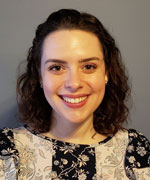Rachael Farber
 My name is Rachael Farber, and I am currently a postdoctoral scholar at The University of Chicago in Prof. Steven Sibener's group. I was not aware of surface science as a field until graduate school where I met Prof. Dan Killelea at Loyola University Chicago.
My name is Rachael Farber, and I am currently a postdoctoral scholar at The University of Chicago in Prof. Steven Sibener's group. I was not aware of surface science as a field until graduate school where I met Prof. Dan Killelea at Loyola University Chicago.
Dan's work investigating the chemical and structural consequences of highly oxidized catalytic metal surfaces is what drew my attention to surface science, and I was particularly interested in the low temperature scanning tunneling microscopy (LT-STM) experiments he planned to do. I then joined Dan's group as a graduate student, and ultimately received my PhD from Loyola University Chicago in 2018 where I used a combination of surface science techniques to study highly oxidized Rh(111).
For my postdoctoral work, I decided to stay in the field of surface science, but switched from studying catalytic metal surfaces to metal surfaces important to particle accelerator science and technology. Current particle accelerator facilities use niobium (Nb) superconducting radio frequency (SRF) cavities. Nb SRF cavity performance is, however, easily attenuated by the presence of hydrogen in the cavity bulk. This hydrogen, which precipitates out as Nb-hydrides at operating temperatures, ultimately causes SRF cavity failure and decreased performance of particle accelerator facilities. In an effort to overcome the performance limitations introduced by hydrogen, we have worked with the Center for Bright Beams (CBB), an NSF Science & Technology Center, to investigate the initial, nano-scale growth and suppression behavior of Nb-nano hydrides on Nb(100).
Our next project, also done in collaboration with the CBB, will focus on elucidating Sn diffusion and incorporation on Nb(100) to inform growth procedures of Nb3Sn SRF cavities, the next generation material for SRF cavities. I have been attending the AVS International Symposium & Exhibition since 2015 as a graduate student, and have continued attending through to this past year's meeting in 2019 as a postdoctoral scholar.
The active surface science community, leadership opportunities for graduate students and postdoctoral scholars, and opportunity for professional networking and scientific collaborations are some of the driving forces for my continued attendance since 2015. Looking forward, I am excited to continue attending these meetings and being involved with AVS as I continue my independent career!